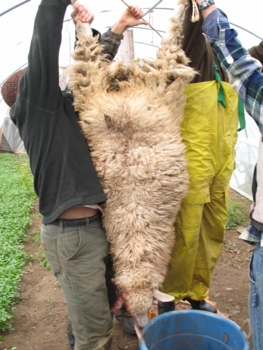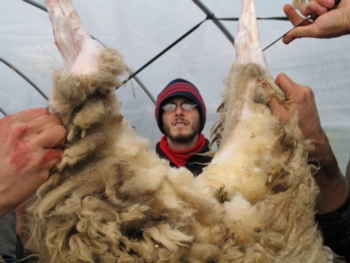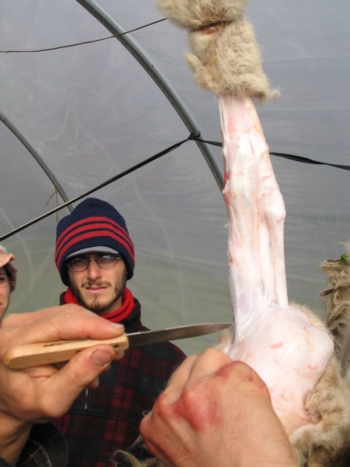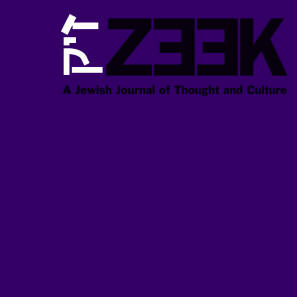 January 07
January 07
Like an Eco-Kosher Jewish Farmer Led to Slaughter
by Alexander Sharone
p. 2 of 2

As the slicing and sawing came to a close, more and more of the lamb was neatly wrapped in white freezer paper and labeled appropriately: primal roast, short loin, valentine chop, riblet, crown roast, cutlet. With its life-blood let, the lamb was now meat. The best cuts had already been pre-ordered by family, friends, and members of the local CSA (Community Supported Agriculture), so the meat would not have to travel very far. In fact, the entire process – slaughtering, cutting, and transporting – had intentionally and conscientiously required very minimal energy costs or automated practices.
The slaughterer's diligent care for respecting the animal, fullest use of available resources, and the invitation for witnessing the act itself all felt right. But as I exited the farm gates of the Chubby Bunny with my fellow eco-Jewish farmers, post-slaughter contemplativeness syndrome set in.

Back to the Sources
In considering the passage in Job 19:26 "From my flesh I see God," the Ba'al Shem Tov – the founder of Hasidism – teaches that "from the physical we can perceive the spiritual.” Riding back to the pasture to attend to Angie, I wondered about the Jewish spiritual import of the slaughter I had just witnessed.
Consider for a moment the biblical significance of the lamb as a symbol of meekness and the shepherd as the model of the selfless guardian of all things chaste. Long before David slay Goliath and was crowned King of Israel, he had demonstrated his bravery as a lowly shepherd, protecting his flock by fighting off wild animals. In Psalm 23, David likens the Lord to a shepherd, illustrating one of the most quintessential relationships between God and mankind. Jesus Christ, as Christianity's genetic and occupational descendant of David, is described as the peaceful warrior/shepherd par excellence. These days one would be hard-pressed to find Baby Jesus in a nativity scene without sheep.
Both Jewish and Christian mythologies offer the apocalyptic icon of the lamb as a harbinger of peace. In Isaiah’s prophetic vision of the messianic era, the wolf lies down with the lamb, signifying the end of predatory-prey relationships among all beings. This powerful image of a future time of peaceful relations also contains the idyllic longing for a return to the Garden of Eden. Soon after banishment of the first humans from the garden, the lamb becomes a target in the open killing season amongst the thorns and thistles of a cruel world.
Since this fall from grace from the herbaceous abundance of the Garden, our human ancestors have been forced to live off the fat and skinny of the land, roaming among the vicissitudes of the natural rhythms of life. In the biblical and a variety of later Jewish worldviews, people satisfied their lust for blood by feasting upon most any living being they could ensnare, while the Jewish people – knee-deep in their holy covenant with the Divine – were granted no such opportunities for wanton excess. The consumption of flesh was limited to meat prepared through ritualized slaughter upon the altar, taming the pangs of bloodthirsty humans.
Today, the remnants of the holy altar for slaughter have been transferred to the kitchen and dining room. At the Sabbath table, for instance, the challah, a term referring to the biblically commanded sacrificial portion given to priests, serves as a reminder and living link to the Temple period. Yet aside from the olive-sized bit of dough that is removed and burnt during halachic preparation, spiritualized burnt-offerings no longer exist. In their place we find many other outlets, most notably, study, rites of prayer, and all variety of jurisdictions in the Jewish legal system, including kashrut. By extending a complex litany of prohibitions pertaining to the slaughter and consumption of meat, the Rabbis guarded against the unfettered expression of human animalistic desires, tying it directly to service to God: "Elazar ben Azariah taught, 'Don’t say ‘I have no desire to eat pig’s flesh,’ but rather say, ‘I would like to eat it, but what can I do seeing that my Father in heaven has decreed against it?’” (Sifra, K’doshim, 11:22)
Angie, Where Will You Lead Us from Here?
Fast-forward to present day kosher slaughterhouses and see how far we have strayed from the tenuous balance of playing the roles of both guardian and holy butcher. Here, a sacred ritual is undone, flesh desecrated, and holy sparks smothered. In 2005, PETA released an undercover video documenting the brutal practices of AgriProcessors, the world’s largest glatt kosher slaughterhouse.  One of the many habitual practices the video revealed occurring at the plant in Postville, Iowa included ripping out the tracheas and esophagi from fully conscious cattle. This is but one glaring violation of the ethical basis of kashrut and the basic Jewish understanding of how to treat animals with compassion. Today’s mechanized extraction of marketplace bound flesh rejects the sacralization of life. The forward march of efficiency renders the spirit spineless, reducing the body of the lamb to a lump of flesh marked as a commodity on a spreadsheet. As humankind's unbridled desire to consume meat and its commodified fulfillment has spiraled out of control, we have engendered complete estrangement of the consumer from the life and death of the animal it devours.
One of the many habitual practices the video revealed occurring at the plant in Postville, Iowa included ripping out the tracheas and esophagi from fully conscious cattle. This is but one glaring violation of the ethical basis of kashrut and the basic Jewish understanding of how to treat animals with compassion. Today’s mechanized extraction of marketplace bound flesh rejects the sacralization of life. The forward march of efficiency renders the spirit spineless, reducing the body of the lamb to a lump of flesh marked as a commodity on a spreadsheet. As humankind's unbridled desire to consume meat and its commodified fulfillment has spiraled out of control, we have engendered complete estrangement of the consumer from the life and death of the animal it devours.
Prophesy reveals that one day we will return to an Edenic vegetarian world where humankind beats swords into plowshares and once again subsists on an entirely green, life-affirming diet. Rav Kook teaches: “In messianic days the effect of knowledge will spread even to animals…and sacrifices in the Temple will consist of vegetation, and it will be pleasing to God as in days of old…” (Olat Rayah, Vol. 1, p. 292). In the meantime, humane slaughter like the kind I witnessed at Chubby Bunny still involves spurts of blood and many reservations. Whether on a factory or family farm, the gruesome realities of slaughter cannot be escaped. Yet taking personal responsibility for the slaughter, by hand and not by hook, allows a relationship of respect to be renewed – an opening, perhaps, to redeeming our humanity and the lamb’s animality at once. The manner in which we conduct ourselves in relation to animal life is but one considerable measure of our evolutionary progress. With humankind’s unique capacity to exercise both brutal dominion and compassionate stewardship on this earth, the tension between these competing instincts shepherds us forward. And whether we reach greener pastures, well, that is up to the shepherd.
Alexander Sharone was born in Israel and raised in Los Angeles. He holds a BA in Sociology from UC Berkeley and is the former national director of Habonim Dror North America. Alexander recently completed Adamah: The Jewish Environmental Fellowship and is currently in Tel Aviv celebrating his grandmother’s 90th birthday.









